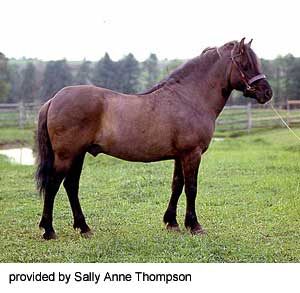
Konik

Introduction: If you have any comments or suggestions, please click here.
Names: Konik, Polish Konik. Apparently, the native word, Konijk, is a general term, meaning "little horse," applied in particular to ponies of primitive type native to Poland and Galicia.
Origin: Comes from Carpathian Mountains of Poland, Russia, and Rumania. Konik ponies are close relations of Tarpans, but lay no claim to being a wild breed.
Breeding: Poland, Galicia. Presumably of direct Tarpan descent; closely resembles the original prehistoric wild breed. As a result of systematic breeding relatively little changed.
Description: They are an inch or so larger than Tarpans, of better conformation, and are both good-natured and live longer.
Action: Energetic movements in all three gaits. Galloping ability.
Body: Not very long neck. Rather extended rump with good barrel. Sloping quarters with low set, full tail.
Color: Base colour often mouse-grey (or mouse-dun) with dorsal stripe, sometimes with zebra stripes on legs. Some of the ponies turn white during winter, with only their face, mane, tail, and fetlocks retaining the normal grey color.
Head: Light, concave profile; short muzzle; small, pointed ears.
Hooves: Small, well-formed, and tough.
Legs: Exceedingly sturdy with hard, clearly marked tendons and joints.
Size: 13 to 14 hands. 52-56 inches.
Temperament: Energetic, willing temperament. The same source also said it is sometimes vicious in character.
Features: Primitive, Tarpan-type indigenous breed. Tough, agile, economic feeder, of incomparable hardiness and endurance. Primitive in appearance and being. Lives to a good age and is very fertile. In winter a thick, woolly coat.
Uses:
Accomplishments:
Curiosities:
Profiles:
Conclusion: